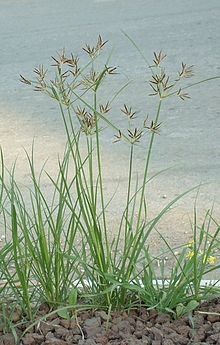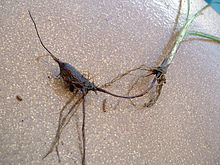- Cyperus rotundus
-
Cyperus rotundus 
Scientific classification Kingdom: Plantae (unranked): Angiosperms (unranked): Monocots (unranked): Commelinids Order: Poales Family: Cyperaceae Genus: Cyperus Species: C. rotundus Binomial name Cyperus rotundus
L.Cyperus rotundus (coco-grass, purple nut sedge, red nut sedge) is a species of sedge (Cyperaceae) native to Africa, southern and central Europe (north to France and Austria), and southern Asia. The word cyperus derives from the Greek "κύπερος" (kuperos)[1] and rotundus is from Latin, meaning "round".[2] The earliest attested form of the word cyperus is the Mycenaean Greek ku-pa-ro, written in Linear B syllabic script.[3]
 A cross section through the flower stem
A cross section through the flower stem
Cyperus rotundus is a perennial plant, that may reach a height of up to 40 cm. The names "nut grass" and "nut sedge" (shared with the related species Cyperus esculentus) are derived from its tubers, that somewhat resemble nuts, although botanically they have nothing to do with nuts.
As in other Cyperaceae, the leaves sprout in ranks of three from the base of the plant. The flower stems have a triangular cross-section. The flower is bisexual and has three stamina and a three-stigma carpel. The fruit is a three-angled achene.
The root system of a young plant initially forms white, fleshy rhizomes. Some rhizomes grow upward in the soil, then form a bulb-like structure from which new shoots and roots grow, and from the new roots, new rhizomes grow. Other rhizomes grow horizontally or downward, and form dark reddish-brown tubers or chains of tubers.
Contents
Invasive problems and erradication
Cyperus rotundus is one of the most invasive weeds known, having spread out to a worldwide distribution in tropical and temperate regions. It has been called "the world's worst weed"[4] as it is known as a weed in over 90 countries, and infests over 50 crops worldwide.[citation needed] In the United States it occurs from Florida north to New York and Minnesota and west to California and most of the states in between.
Its existence in a field significantly reduces crop yield, both because it is a tough competitor for ground resources, and because it is allelopathic, the roots releasing substances harmful to other plants. Similarly, it also has a bad effect on ornamental gardening. The difficulty to control it is a result of its intensive system of underground tubers, and its resistance to most herbicides. It is also one of the few weeds that cannot be stopped with plastic mulch.[citation needed]
Weed pulling in gardens usually results in breakage of roots, leaving tubers in the ground from which new plants emerge quickly. Ploughing distributes the tubers in the field, worsening the infestation; even if the plough cuts up the tubers to pieces, new plants can still grow from them. In addition, the tubers can survive harsh conditions, further contributing to the difficulty to eradicate the plant.
Most herbicides may kill the plant's leaves, but most have no effect on the root system and the tubers. Glyphosphate will kill some of the tubers (along with most other plants) and repeated application can be successful. Halosulfuron, brand name "Manage" (now renamed "SedgeHammer" in the USA) or "Sempra" in Australia, will control nut grass after repeated applications without damaging lawns.[citation needed]
Uses and positive aspects
Despite its bad reputation, Cyperus rotundus has several beneficial uses.
Folk Medicine
The plant is used in popular medicine:
- In the Traditional Chinese medicine it is considered the primary qi regulating herb.
- The plant is mentioned in the ancient Indian ayurvedic medicine Charaka Samhita (ca. 100 A.D.). Modern ayurvedic medicine uses the plant for treating fevers, digestive system disorders, dysmenorrhea and other maladies.
- Arabs of the Levant traditionally use roasted tubers, while they are still hot, or hot ashes from burned tubers, to treat wounds, bruises, carbuncles, etc.
Modern uses and studies
Modern alternative medicine recommends using the plant to treat nausea, fever and inflammation; for pain reduction; for muscle relaxation and many other disorders.
Several pharmacologically active substances have been identified in Cyperus rotundus: α-cyperone, β-selinene, cyperene, cyperotundone, patchoulenone, sugeonol, kobusone, and isokobusone, that may scientifically explain the folk- and alternative-medicine uses.
Food
Despite the bitter taste of the tubers, they are edible and have a nutritional value. The plant is known to have been eaten in Africa in famine-stricken areas.
In addition, the tubers are an important nutritional source of minerals and trace elements for migrating birds such as cranes.
References
- ^ κύπερος, Henry George Liddell, Robert Scott, A Greek-English Lexicon, on Perseus Digital Library
- ^ rotundus, Charlton T. Lewis, Charles Short, A Latin Dictionary, on Perseus Digital Library
- ^ Palaeolexicon, Word study tool of ancient languages
- ^ Holm et al., LeRoy G.; Plucknett, Donald L.. (1977). The World's worst weeds: Distribution and biology. Hawaii: University Press of Hawaii.
External links
- Flora Europaea: Cyperus rotundus
- Germplasm Resources Information Network: Cyperus rotundus
- USDA Plants Profile: Cyperus rotundus
- USDA Natural Resources Conservation Service: Cyperus rotundus (pdf file)
- Use in Chinese and Ayurvedic medicine
- A Tel-Aviv University study mentioning its nutritional importance for migrating birds (in Hebrew)
- Caldecott, Todd (2006). Ayurveda: The Divine Science of Life. Elsevier/Mosby. ISBN 0723434107. Contains a detailed monograph on Cyperus rotundus (Musta; Mustaka) as well as a discussion of health benefits and usage in clinical practice. Available online at http://www.toddcaldecott.com/index.php/herbs/learning-herbs/310-musta
Categories:- Cyperus
- Edible nuts and seeds
- Invasive plant species
- Medicinal plants
Wikimedia Foundation. 2010.


